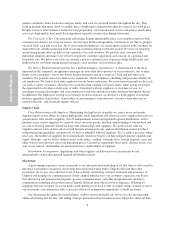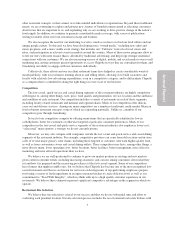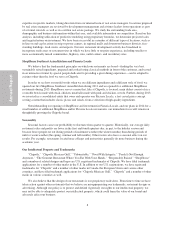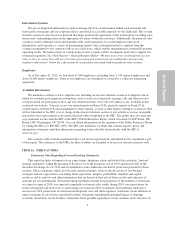Chipotle 2013 Annual Report Download - page 18
Download and view the complete annual report
Please find page 18 of the 2013 Chipotle annual report below. You can navigate through the pages in the report by either clicking on the pages listed below, or by using the keyword search tool below to find specific information within the annual report.
we have. Among our main competitors are a number of multi-unit, multi-market Mexican food or burrito
restaurant concepts, some of which are expanding nationally. Some of these competitors, and other fast casual
concepts, have sought to duplicate various elements of our business operations, and more chains may copy us to
varying degrees in the future. Additionally, our newer concepts, ShopHouse Southeast Asian Kitchen and
Pizzeria Locale, operate in markets in which there are numerous competitors, including a number of large and
well-known brands. A number of other companies or individuals in the restaurant industry have recently opened
or invested in fast-casual pizza concepts. In addition, our strategy includes opening additional restaurants in
existing markets, and as we do so sales may decline in our previously-opened restaurants as customers who
frequent our established restaurants begin to visit a newly-opened restaurant instead.
Several of our competitors compete by offering menu items that are specifically identified as low in
carbohydrates, better for customers or otherwise targeted at particular consumer preferences. Many of our
competitors in the fast-casual and quick-service segments of the restaurant industry also emphasize lower-cost,
“value meal” menu options, a strategy we do not currently pursue. Our sales may be adversely affected by these
products and price competition.
Moreover, we may also compete with companies outside the fast casual and quick service and casual dining
segments of the restaurant industry. For example, competitive pressures can come from deli sections and in-store
cafés of several major grocery store chains, including those targeted at customers who want higher-quality food,
as well as from convenience stores and casual dining outlets. These competitors may have, among other things, a
more diverse menu, lower operating costs, better locations, better facilities, better management, more effective
marketing and more efficient operations than we have.
Any of these competitive factors may adversely affect us and reduce our sales and profits.
Failure to receive frequent deliveries of higher-quality food ingredients and other supplies could harm
our operations.
Our ability to maintain our menu depends in part on our ability to acquire ingredients that meet our
specifications from reliable suppliers. Shortages or interruptions in the supply of ingredients caused by
unanticipated demand, problems in production or distribution, food contamination, inclement weather, a supplier
ceasing operations or other conditions could adversely affect the availability, quality and cost of our ingredients,
which could harm our operations. We have almost no long-term contracts with suppliers, and we have relied
largely on a third party distribution network with a limited number of distribution partners. If any of our
distributors or suppliers performs inadequately, or our distribution or supply relationships are disrupted for any
reason, our business, financial condition, results of operations or cash flows could be adversely affected. We
currently depend on a limited number of suppliers for some of our key ingredients, including beef, pork, chicken,
beans, rice, sour cream, cheese, and tortillas. Due to the unique nature of the products we receive from our Food
With Integrity suppliers and as described in more detail below under “Risks Related to our Unique Business
Strategy—We may not persuade customers of the benefits of paying our prices for higher-quality food,” these
suppliers could be more difficult to replace if we were no longer able to rely on them. If we have to seek new
suppliers and service providers we may be subject to pricing or other terms less favorable than those we currently
enjoy. If we cannot replace or engage distributors or suppliers who meet our specifications in a short period of
time, that could increase our expenses and cause shortages of food and other items at our restaurants, which
could cause a restaurant to remove items from its menu. If that were to happen and customers change their dining
habits as a result, affected restaurants could experience significant reductions in sales during the shortage or
thereafter. Our focus on a limited menu would make the consequences of a shortage of a key ingredient more
severe.
Changes in customer tastes and preferences, spending patterns and demographic trends could cause sales
to decline.
Changes in customer preferences, general economic conditions, discretionary spending priorities,
demographic trends, traffic patterns and the type, number and location of competing restaurants affect the
16
Annual Report
























